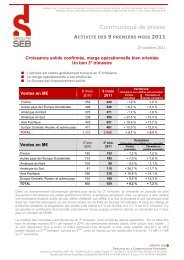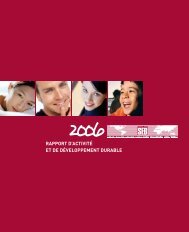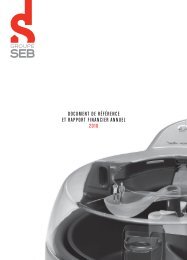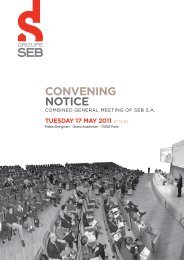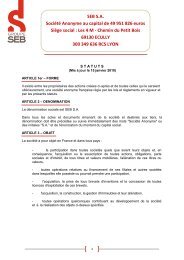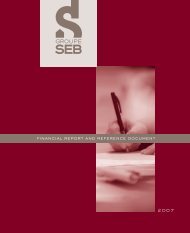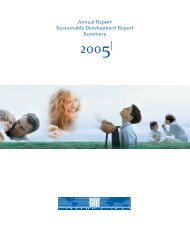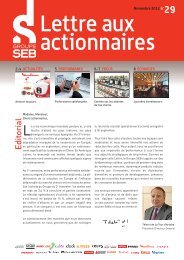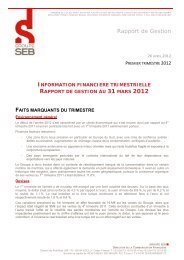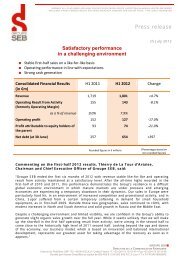financial report and registration document 2011 - Groupe SEB
financial report and registration document 2011 - Groupe SEB
financial report and registration document 2011 - Groupe SEB
You also want an ePaper? Increase the reach of your titles
YUMPU automatically turns print PDFs into web optimized ePapers that Google loves.
5 Notes<br />
Consolidated fi nancial statements<br />
to the consolidated fi nancial statements<br />
Deferred tax assets are recognised for deductible temporary differences <strong>and</strong><br />
tax loss carryforwards to the extent that it is probable that future taxable<br />
profi ts will be available against which they can be utilised.<br />
Deferred tax assets previously unrecognised at the date of a business<br />
combination or during the twelve-month fair value measurement period are<br />
subsequently recognised as an adjustment to profi t or loss provided they<br />
meet the recognition criteria.<br />
In accordance with IAS 12, deferred tax assets <strong>and</strong> liabilities are not<br />
discounted.<br />
1.4.10. Employee benefi ts<br />
A) PENSION AND OTHER POST-EMPLOYMENT BENEFIT PLANS<br />
In some countries, the Group is required to pay length-of-service awards to<br />
employees on retirement or pension benefi ts under formal pension plans. The<br />
Group also pays contributions to government-sponsored pension schemes<br />
in its various host countries. The accounting treatment of these pension <strong>and</strong><br />
other post-employment benefi t plans depends on the type of plan, as follows:<br />
Defi ned contribution plans<br />
Contributions to these plans are recognised as an expense for the period<br />
to which they relate.<br />
Defi ned benefi t plans<br />
In accordance with IAS 19 – Employee Benefi ts, obligations under defi ned<br />
benefi t plans are calculated annually by independent actuaries using the<br />
projected unit credit method based on fi nal salaries. The projected unit credit<br />
method sees each period of service as giving rise to an additional unit of<br />
benefi t entitlement <strong>and</strong> measures each unit separately to build up the fi nal<br />
obligation, which is then discounted.<br />
The actuarial assumptions used to calculate the obligation include staff<br />
turnover rates, mortality rates, the discount rate <strong>and</strong> the expected retirement<br />
age. The assumptions vary according to local laws <strong>and</strong> regulations in the<br />
host countries concerned.<br />
Actuarial gains <strong>and</strong> losses arising from the effects of changes in actuarial<br />
assumptions <strong>and</strong> experience adjustments on plan obligations <strong>and</strong> assets are<br />
recognised in profi t by the corridor method. Under this method, the portion<br />
of the net cumulative unrecognised actuarial gains <strong>and</strong> losses that exceeds<br />
the greater of 10% of the present value of the defi ned benefi t obligation <strong>and</strong><br />
10% of the fair value of any plan assets at that date is amortised over the<br />
remaining service lives of the employees concerned.<br />
A provision is recorded in the balance sheet for any unfunded obligations,<br />
corresponding to defi ned benefi t obligations not covered by plan assets, net<br />
of unrecognised gains <strong>and</strong> losses.<br />
For plans that have a surplus – corresponding to the excess of plan assets<br />
over the defi ned benefi t obligation – the Group applies the limit provided for<br />
in IAS 19 in measuring any asset recognised in the balance sheet.<br />
B) OTHER LONG-TERM BENEFIT PLANS<br />
Certain subsidiaries pay jubilees to employees who have completed a<br />
certain number of years’ service or offer employees “time savings accounts”.<br />
The cost of these long-term benefi ts is calculated on an actuarial basis<br />
<strong>and</strong> recognised in profi t over the service lives of the employees concerned.<br />
Actuarial gains <strong>and</strong> losses are recognised immediately in profi t during the<br />
period in which they are generated, as their deferral is not allowed under<br />
IFRS.<br />
Pension <strong>and</strong> other post-employment benefi t costs are classifi ed as operating<br />
expenses, except for the interest cost, which is included in other fi nancial<br />
income <strong>and</strong> expense in accordance with the alternative treatment allowed<br />
under IAS 19.<br />
In accordance with IFRS 1 – First-time Adoption of International Financial<br />
Reporting St<strong>and</strong>ards, cumulative actuarial gains <strong>and</strong> losses at 1 January<br />
2004 were included in provisions for pensions <strong>and</strong> other post-employment<br />
benefi t obligations at that date by adjusting equity. <strong>Groupe</strong> <strong>SEB</strong> has elected<br />
not to use the option available in the amended version of IAS 19 whereby<br />
entities may recognise actuarial gains <strong>and</strong> losses under defi ned benefi t<br />
pension plans directly in equity as from 1 January 2006.<br />
C) SHARE-BASED PAYMENTS<br />
Stock option plans are measured <strong>and</strong> recognised in accordance with IFRS 2<br />
– Share-based Payment. Stock options represent a benefi t for the grantee<br />
<strong>and</strong>, accordingly, are treated as part of the Group’s compensation costs.<br />
Option grants are not cash-settled, <strong>and</strong> the benefi t is therefore recognised<br />
as an expense over the vesting period by adjusting equity, for an amount<br />
corresponding to the fair value of the underlying equity instruments. As<br />
the stock options granted to employees of Group subsidiaries are only<br />
exercisable for <strong>SEB</strong> S.A. shares they are deemed to be equity-settled sharebased<br />
payments.<br />
Fair values are determined using the Black & Scholes option pricing model.<br />
This model takes into account the option exercise price <strong>and</strong> period, market<br />
data at the grant date (risk-free interest rate, share price, volatility, expected<br />
dividends) <strong>and</strong> grantee behaviour assumptions.<br />
IFRS 2 has been applied only to stock options granted after 7 November<br />
2002 that had not yet vested at 1 January 2005. As allowed under IFRS 1,<br />
no options granted prior to 7 November 2002 have been restated.<br />
1.4.11. Provisions<br />
In accordance with IAS 37 – Provisions, Contingent Liabilities <strong>and</strong> Contingent<br />
Assets, a provision is recognised when the Group has a present obligation<br />
(legal or constructive) as a result of a past event, it is probable that an<br />
outfl ow of resources embodying economic benefi ts will be required to settle<br />
the obligation, <strong>and</strong> a reliable estimate can be made of the amount of the<br />
obligation.<br />
A) PROVISIONS FOR WARRANTY COSTS<br />
The Group provides a warranty on its products. The estimated costs of the<br />
warranty are accrued at the time of sale, based on historical data.<br />
This item also includes provisions for product recalls, which are set up when<br />
the recall is decided.<br />
B) PROVISIONS FOR CLAIMS AND LITIGATION<br />
As a general principle, all known claims <strong>and</strong> litigation involving the Group<br />
are reviewed by management at each period-end. All necessary provisions<br />
have been recorded to cover the related risks, as estimated after obtaining<br />
advice from outside legal advisors.<br />
88 GROUPE <strong>SEB</strong> Financial Report <strong>and</strong> Registration Document <strong>2011</strong>



